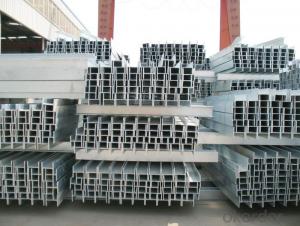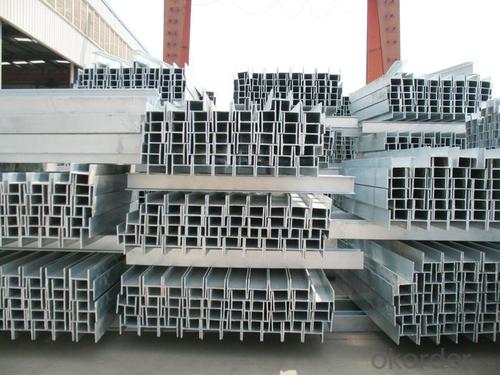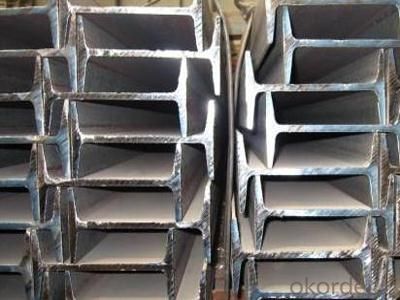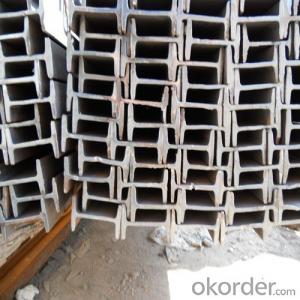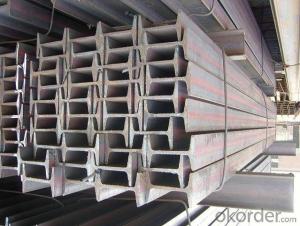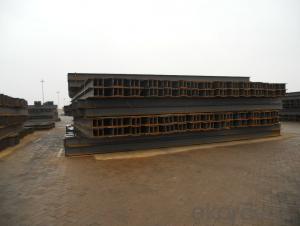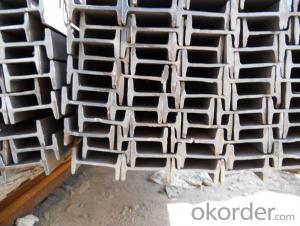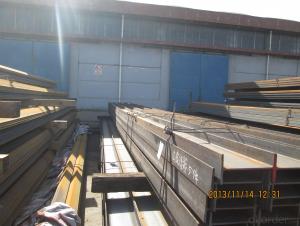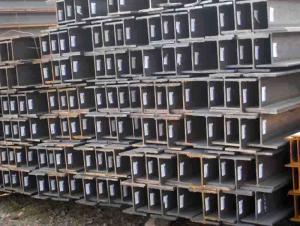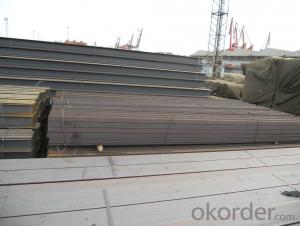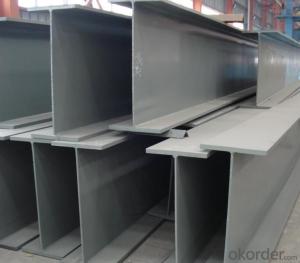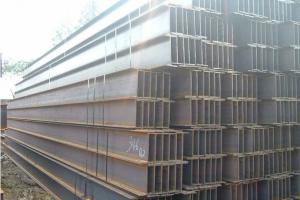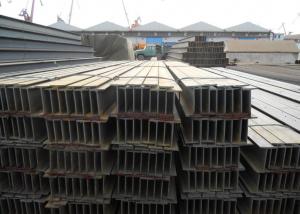Thin steel H BEAM for construction Equivalent
- Loading Port:
- Tianjin
- Payment Terms:
- TT or LC
- Min Order Qty:
- 25 m.t
- Supply Capability:
- 100000 m.t/month
OKorder Service Pledge
OKorder Financial Service
You Might Also Like
Product Description:
OKorder is offering thin steel H BEAM for construction Equivalent at great prices with worldwide shipping. Our supplier is a world-class manufacturer of steel, with our products utilized the world over. OKorder annually supplies products to European, North American and Asian markets. We provide quotations within 24 hours of receiving an inquiry and guarantee competitive prices.
Product Applications:
Thin steel H BEAM are ideal for structural applications and are widely used in the construction of buildings and bridges, and the manufacturing, petrochemical, and transportation industries.
Product Advantages:
OKorder's steel H BEAM are durable, strong, and resist corrosion.
Main Product Features:
· Premium quality
· Prompt delivery & seaworthy packing (30 days after receiving deposit)
· Corrosion resistance
· Can be recycled and reused
· Mill test certification
· Professional Service
· Competitive pricing
Product Specifications:
Manufacture: steel H BEAM
1. Standard: JIS 3192
2. Grade: SS400 or Equivalent
3. Length: 10m, 12m as following table
4. Invoicing on theoretical weight or actual weight as customer request
5.Payment: TT or L/C
Packaging & Delivery of Hot Rolled H-Beam Steel for Building Structures
1. Packing: it is nude packed in bundles by steel wire rod
2. Bundle weight: not more than 3.5MT for bulk vessel; less than 3 MT for container load
3. Marks:
Color marking: There will be color marking on both end of the bundle for the cargo delivered by bulk vessel. That makes it easily to distinguish at the destination port.
Tag mark: there will be tag mark tied up on the bundles. The information usually including supplier logo and name, product name, made in China, shipping marks and other information request by the customer.
If loading by container the marking is not needed, but we will prepare it as customer request.
4. Transportation: the goods are delivered by truck from mill to loading port, the maximum quantity can be loaded is around 40MTs by each truck. If the order quantity cannot reach the full truck loaded, the transportation cost per ton will be little higher than full load.
5. Delivered by container or bulk vessel
FAQ:
Q1: What makes stainless steel stainless?
A1: Stainless steel must contain at least 10.5 % chromium. It is this element that reacts with the oxygen in the air to form a complex chrome-oxide surface layer that is invisible but strong enough to prevent further oxygen from "staining" (rusting) the surface. Higher levels of chromium and the addition of other alloying elements such as nickel and molybdenum enhance this surface layer and improve the corrosion resistance of the stainless material.
Q2: Can stainless steel rust?
A2: Stainless does not "rust" as you think of regular steel rusting with a red oxide on the surface that flakes off. If you see red rust it is probably due to some iron particles that have contaminated the surface of the stainless steel and it is these iron particles that are rusting. Look at the source of the rusting and see if you can remove it from the surface.
Images:
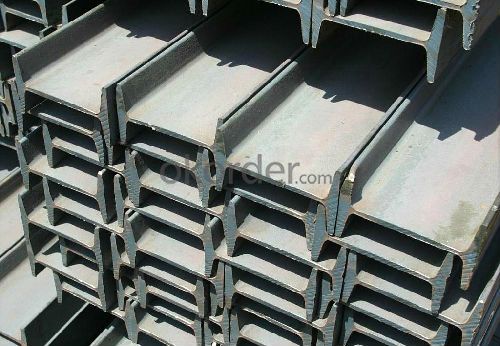


- Q: How do Steel H-Beams perform in terms of sound insulation?
- When it comes to sound insulation, steel H-Beams, which are frequently utilized in construction, do not offer considerable properties in this regard. The main purpose of steel H-beams, due to their structural design and material composition, is to bear loads rather than provide soundproofing. For effective sound insulation, specific soundproofing materials like acoustic panels, insulation batts, or resilient channels are typically employed. As a result, if sound insulation is a priority, additional measures like these should be taken in conjunction with the use of steel H-beams.
- Q: What are the different factors that affect the cost of steel H-beams?
- There are several factors that can affect the cost of steel H-beams. 1. Raw material costs: The price of steel is influenced by various factors such as supply and demand, global economic conditions, and the cost of raw materials. Fluctuations in these factors can impact the overall cost of steel H-beams. 2. Manufacturing process: The production process for steel H-beams involves various steps such as melting, casting, rolling, and finishing. The complexity and efficiency of these processes can affect the cost of production, which in turn affects the final price of H-beams. 3. Size and weight: The dimensions and weight of steel H-beams play a significant role in determining their cost. Larger and heavier H-beams require more raw materials and additional manufacturing processes, resulting in higher costs. 4. Quality and grade: The quality and grade of steel used in H-beams can also influence their cost. Higher-grade steels with superior strength and durability tend to be more expensive compared to lower-grade options. 5. Market demand: The demand for steel H-beams can also impact their cost. When demand is high and supply is limited, prices tend to rise. Conversely, when demand is low and supply exceeds it, prices may decrease. 6. Transportation and logistics: The cost of transporting steel H-beams from the manufacturing site to the buyer's location can add to the overall cost. Factors such as distance, mode of transportation, and fuel prices can affect transportation costs. 7. Market competition: The level of competition among steel manufacturers and suppliers can influence the pricing of H-beams. In a highly competitive market, companies may offer competitive pricing to attract customers, while in less competitive markets, prices may be higher. 8. Currency exchange rates: Steel is a globally traded commodity, and fluctuations in currency exchange rates can impact the cost of imported steel H-beams. Changes in exchange rates between the country of origin and the destination country can affect the final price. It is important to consider these factors when estimating the cost of steel H-beams, as they can vary over time and have a significant impact on the overall budget for construction or manufacturing projects.
- Q: What is the weight of a typical steel H-beam?
- The weight of a typical steel H-beam can vary depending on its size and dimensions. However, as a general guideline, an H-beam weighing around 33 pounds per foot (or approximately 49 kilograms per meter) is considered typical. It is important to note that the weight can vary based on factors such as the specific alloy of steel used, the manufacturing process, and any additional modifications or treatments applied to the H-beam. For accurate and precise weight information, it is recommended to refer to the manufacturer's specifications or consult with a structural engineer.
- Q: Can steel H-beams be used in marine applications?
- Yes, steel H-beams can be used in marine applications. Steel H-beams are commonly used in marine construction for various purposes such as supporting structures, shipbuilding, and offshore platforms. Their high strength and durability make them suitable for withstanding the harsh conditions of marine environments, including corrosion, waves, and saltwater exposure. Additionally, their uniform shape and versatility make them a preferred choice for constructing marine structures that require strength and stability.
- Q: How do steel H-beams perform in areas with high levels of seismic activity?
- Steel H-beams are widely used in areas with high levels of seismic activity due to their excellent performance during earthquakes. Their strong structural integrity and flexibility allow them to absorb and dissipate seismic forces, reducing the risk of collapse or structural damage. Additionally, steel is a ductile material, meaning it can bend and deform under stress without breaking, further enhancing its performance in seismic zones. Therefore, steel H-beams are considered a reliable and safe choice for construction in areas prone to earthquakes.
- Q: How are steel H-beams manufactured?
- Steel H-beams are manufactured through a process called hot rolling, where molten steel is poured into molds and then passed through a series of rollers to shape it into the desired H-beam profile. The heat and pressure applied during hot rolling help to achieve the required strength and structural integrity of the beams. After the hot rolling process, the H-beams are further cooled, cut to the desired length, and undergo various quality checks before being ready for use in construction projects.
- Q: Hot rolled H section steel
- The flange width, lateral stiffness.The bending capacity, than the beam about 5%-10%.The two flange surfaces parallel to each other makes the connection, convenient manufacture and installation.We compared with welded I-beam with low cost, high precision, small residual stress, without expensive welding and weld testing, saving the cost of steel production is about 30%.The same section under load. The structure of hot rolled H steel than the traditional steel structure weight 15%-20%.We compared with the concrete structure, the structure of hot rolled H steel can be increased by 6% of the area, and the structure to reduce weight 20% to 30%, reducing the internal force of structure design.The H type steel can be processed into T type steel honeycomb beam can be formed by the combination of all kinds of section form, design and production greatly satisfy the engineering demand.
- Q: How do steel H-beams distribute loads?
- The distribution of loads in steel H-beams is achieved through a combination of their shape and material properties. The letter "H" shape of these beams offers a favorable strength-to-weight ratio, making them efficient in carrying loads. The flanges, located at the top and bottom horizontal sections of the beam, are specifically designed to resist bending and shear forces. By distributing the load over a larger area, stress concentrations are reduced, preventing deformation or failure. The vertical web, positioned between the flanges, provides additional structural support and stability. It effectively resists compression and tension forces, ensuring that the beam does not buckle or collapse when subjected to heavy loads. Moreover, the web aids in evenly distributing the load along the entire length of the beam. The material properties of steel also play a crucial role in load distribution. Steel possesses notable strength and stiffness, allowing H-beams to withstand heavy loads without experiencing significant deflection. The properties of steel, such as its Young's modulus and yield strength, contribute to the beam's effective load distribution capabilities. In summary, steel H-beams distribute loads by utilizing their structural stability provided by their shape and the load-bearing capabilities of their material properties. This makes them a popular choice for a wide range of construction and engineering applications.
- Q: Can steel H-beams be used for commercial parking structures?
- Yes, steel H-beams can be used for commercial parking structures. Steel H-beams are commonly used in construction due to their high strength and durability. They provide excellent support and can withstand heavy loads, making them ideal for parking structures that are designed to accommodate numerous vehicles. Steel H-beams also offer flexibility in design, allowing for efficient use of space and the ability to create multi-level parking structures. Additionally, steel is a sustainable and recyclable material, making it an environmentally friendly choice for commercial parking structures. Overall, steel H-beams are a reliable and cost-effective option for constructing sturdy and long-lasting parking structures in commercial settings.
- Q: How do steel H-beams perform in oil and gas industry applications?
- Steel H-beams are highly durable and versatile, making them well-suited for various applications in the oil and gas industry. They offer excellent load-bearing capacity and structural stability, making them ideal for constructing platforms, support structures, and equipment frameworks. Additionally, steel H-beams possess high resistance to corrosion, which is crucial in the presence of oil and gas. Overall, steel H-beams are a reliable choice in the oil and gas industry due to their strength, durability, and ability to withstand harsh environments.
Send your message to us
Thin steel H BEAM for construction Equivalent
- Loading Port:
- Tianjin
- Payment Terms:
- TT or LC
- Min Order Qty:
- 25 m.t
- Supply Capability:
- 100000 m.t/month
OKorder Service Pledge
OKorder Financial Service
Similar products
Hot products
Hot Searches
Related keywords
